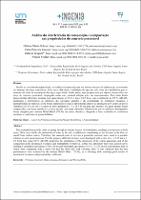Análise da interferência da composição e compactação nas propriedades do concreto permeável
Date
2022-12-12Author
Schein, Débora Maria
Wagner, Rafaela
Perreira Rossato, Fabio
Seidler, Nelson
Metadata
Show full item recordAbstract
Devido ao crescimento populacional, as cidades estão passando por um intenso processo de urbanização, acarretando no aumento das áreas construídas. Estas áreas dificultam a infiltração da água no solo, além de contribuírem para o aumento da vazão de escoamento das águas superficiais. Sendo assim, essa pesquisa tem por objetivo desenvolver um traço de concreto permeável, empregado como uma possível solução para tais inconvenientes. Para tanto foram desenvolvidas diferentes misturas com uma relação a/c 0,31 e traço 1:4,5 fixos, com a utilização de CP V-ARI RS, analisando a interferência da dimensão dos agregados graúdos e da compactação na resistência mecânica e permeabilidade do material. Desta forma, realizaram-se ensaios laboratoriais através da moldagem de 8 corpos de prova cilíndricos de 10 x 20 cm e 4 corpos de prova prismáticos 15 x 15 x 50 cm para cada mistura, dos quais metade foram compactados com haste metálica e a outra metade com mesa vibratória. Observou-se que os melhores desempenhos foram atingidos pela mistura Brita0:Brita1 (70:30), em mesa vibratória, chegando a bons resultados de resistência mecânica e coeficiente de permeabilidade. Due to population growth, cities are going through an intense process of urbanization, resulting in an increase in built areas. These areas hinder the infiltration of water in the soil, in addition to contributing to the increase in the flow of runoff from surface waters. Therefore, this research aims to develop a permeable concrete trace, used as a possible solution to such inconveniences. For this purpose, different mixtures were developed with a ratio of a / c 0.31 and a 1: 4.5 fixed line, using CP V-ARI RS, analyzing the interference of the dimension of the coarse aggregates and of the compaction in the mechanical resistance and permeability of material. In this way, laboratory tests were carried out by molding 8 cylindrical specimens of 10 x 20 cm and 4 prismatic specimens of 15 x 15 x 50 cm for each mixture, half of which were compacted with a metal rod and the other half with vibrating table. It was observed that the best performances were achieved by the mixture Brita0: Brita1 (70:30), on a vibrating table, reaching good results of mechanical resistance and permeability coefficient.
Collections
- Revista +INGENIO [53]
The following license files are associated with this item:



